Old and new – so close together
A German version of this posting you’ll find here.
Eine deutsche Version dieses Artikels finden Sie hier.
Just where we ended the first part of our little walk through Fukuoka, we’ll start again today: At the Kushida shrine (櫛田神社 / くしだじんじゃ) which I have chosen to be my dearest one. And, just in order to prove that this shrine also has its charm in broad daylight, here are some images I took in the morning. For all those who are either not willing or able to wait for sunset, it may be consolation to see that a daytime visit to the Kushida shrine is just as worthwhile.
However, after that the first item on our new agenda shall be headed for. The easiest way to reach it is by taking the subway line „Kūkō“ (airport) (地下鉄空港線 / ちかてつくうこうせん) to Ōhirokōen (大濠公園 / おおほうりこうえん). It takes just a few minutes and costs 250 Yen. By the way, in Fukuoka also the „Suica“ can be used when riding the subways.).
The Ōhirokōen, one of the largest, if not the largest park of the city, is home to the grand remains of the castle of Fukuoka (福岡城 / ふくおかじょう), also known as “Maizuru Castle” (舞鶴城 / まいつるじょう) or “Stone Castle” (石城/ せきじょう), which dates back to the early years of the Edo era (i.e. early 17th century). With an expanse of 47,000 square meters this castle of the Kuroda clan used to be the largest fortification in Kyūshū. It is said that it boasted 47 wooden towers. Nevertheless, the reign of the Kuroda came to an end after 12 generations and more than 270 years during the Meiji restoration. In 1871 the castle was abandoned and its buildings either turned down or moved elsewhere.
None of the original buildings of the castle has survived. But that doesn’t mean that the castle is less breathtaking now. And even those who don’t really care for giant walls may at least appreciate the park around them – or the rather spectacular view from the top of the highest walls. Climbing the top of the foundation of the main tower of the castle is certainly worth the extra effort.
There are, by the way, still some speculations regarding the shape and height of the main tower of the castle. It is, however, believed that it was a rather impressive five-story building. Do we have to assume sloppiness in the documentation of the building? Or is it just due to the fact that digital cameras weren’t that good in the 19th century…
The few buildings one can see on the castle’s grounds are easily accounted for. The most impressive one is certainly the “Shimonohashi Gomon” (下の橋御門 / しものはしごもん), the gate closest to the subway station. However, this gate was built only in 1805 and was lost in a suspicious fire in 2000. No wonder it looks rather new today. It’s a very pretty good example of the fortified gate to the castle.
Should you approach the castle from the park in the west of it, you’ll probably pass the two gates, Najimamon (名島門 / なじまもん) and Nagayamon (長屋門 / ながやもん). There is a good reason why the Najimamon is named that way: It was initially built as a gate to the castle of Najima. However, when the much larger castle in Fukuoka was built, it was donated to the Kuroda ruler and transported to its new location. To give buildings away and to transport them over long distances has been a tradition in Japan for many centuries.
Already from the foundation of the main tower of the castle, the next “milestone” of our tour cannot be overlooked: The Fukuoka Tower (福岡タワー / ふくおかタワー).
It is just two stations by the Kūkō line (空港線 / くうこうせん) of the subway from Ōhirokōen (大濠公園 / おおほうりこうえん) to Nishishin (西新 / にししん). It may be more than 15 minutes you’ll have to walk from there, but there just isn’t any closer subway station, if you don’t want to miss the Fukuoka Tower (福岡タワー / ふくおかタワー). It is located in the slightly futuristic district of high rise buildings called Momochihama (百道浜 / ももちはま), just next to the long beaches at the Bay of Hakata.
En route to the tower you’ll pass the grounds of the Seinan Gakuin University (西南学院大学 / せいなんがくいんだいがく) – an extensive complex of buildings which is just as uninteresting as most of the Japanese university buildings. It’s just mentioned here as a kind of “landmark”. After crossing the Yokatopia Dōri the Fukuoka Tower will eventually become visible amidst the high rise buildings.
Its height of 234 metre make the Fukuoka Tower the tallest tower of its kind (“seaside tower”) in Japan. It is also the (new!) landmark of Fukuoka. Construction took just 14 months, and it was opened in 1989 (construction cost is reported as 6 billion Yen). On a base area of 3,110 square meters (which looked much smaller to me) the tower rests so soundly that it supposed to withstand earthquakes of a magnitude of 7 (before the tower was erected there was never a recorded earthquake stronger than magnitude 6 in Fukuoka) and storms up to a speed of 63 metres/second (i.e. 227 km/h) – there was never a storm stronger than 49 metres/second in Fukuoka. There is a good reason for the stability of the tower: even though the construction above ground weights 3,500 tons, the foundation below ground is as massive as 25,000 tons.
The steel truss construction is covered by 8,000 semi-transparent mirrors. Therefore it shouldn’t come as a surprise that the triangular tower looks more like a much higher high rise building than a tower.
Even though the top observatory of the Fukuoka Tower is located in “only” 123 metres height, it offers the most spectacular 360° panorama of the surrounding districts, mountains and the islands off the coast.
By the way: For the 70-seconds lift-ride to the observatories foreigners only pay the “group” admission fee – i.e. adults pay just 640 Yen instead of 800 Yen. And that’s really money well-spent.
Directly beneath the Fukuoka Tower there is a tiny man-made island on pillars called the “Wedding Island Marizon” (ウエディング アイランド マリゾン) home to a replica of a Spanish (?) monastery. There is no admission to this replica abbey, unless you decide to get married or get invited to a wedding party here. But you can walk around it and thus reach the marina for the boats of the “Umi-no Nakamichi” line that bring you to the large island off coast of the city (it’s supposed to feature a sea life park).
Naturally, you may have your own opinion regarding such replica buildings. But the location of this small island sure is magnificent.
And if you don’t develop any kind of vacation feeling at the marvellous beaches of the “Seaside Momochi Beach Park” (ジーサイドももち海浜公園 / シーサイドももちかいひんこうえん) you’ve either had beach vacations enough or you just don’t know how wonderful a beach vacation can be.
Latest on your way back to the subway (unless you choose to take one of the bus lines) you ought to consider the delightful boulevard that stretches south from the Fukuoka Tower, leading to the Yokatopia Dōri. It passes the Fukuoka City Sōgō Library (福岡市総合図書館 / ふくおかしそうごうとしょかん) and the City Museum (福岡市博物館 / ふくおかしはくぶつかん). From the crossing “Hakubutsukanmae” (博物館前 / はくぶつかんまえ) it’s less than 15 minutes to the subway station “Nishishin” (西新 / にししん), and from there it’s just a short hop back to the centre of the city where our next target is waiting for us: the old landmark of Fukuoka, the Hakata Port Tower (博多ポートタワー).
Starting point for the next section of our tour is the subway station “Nakasu-Kawabata” (中州川端 / なかすかわばた) and from there the right (eastern) bank of the river Nakagawa (那珂川 / なかがわ) brings us into northeastern direction. This part of the walk may not be the most pleasant one, but it takes just about 20 minutes. Nevertheless, if you feel like having walkied enough for a day already, why not spoil yourself with a taxi ride.
Before we enter the port area, we’ll have a look at the pretty shrine that appears to be a little “lost” between the concrete colossuses of the Hotel Ōkura Fukuoka (ホテルオークラ福岡) and the Hakata Riverain (博多リバレイン) (why there is “eeny meeny miny mo” written on this building – frankly, I don’t know – but I do know that it houses the Museum for Asian Art). Obviously nobody had the courage to make the spritis living in this shrine homeless when the building at the river’s banks were built… This shrine, the Kagami Tenmangū (鏡天満宮 / かがみてんまんぐう), may not win the first prize for religious importance, but its location in the middle of megalomania of the 90s of the last century makes it unique. One even feels compelled to forgive the Halloween decoration.
The harbour area isn’t among the architectural highlights of the city, but a number of small “Love Hotels” make it quite remarkable. And who would expect to find a Lutheran church here? However the harbour feeling is also not really disturbed by the many apartment towers built in this area east of the river. I for one couldn’t help but feeling a bit reminded on Hamburg (northern Germany).
The Hakata Port Tower (博多ポートタワー) which was built in 1964 looks a touch sad – just like it hasn’t yet come to terms with the fact that the Fukuoka Tower has deprived it of its rank as “landmark of Fukuoka”. Nevertheless, I would have loved to go up to its observatory and to enjoy the view from up there. Unfortunately, the tower was undergoing some maintenance when I was there – good for the tower.
The 103-metres-Tower offers an observatory in a height of 73,5 metres. And I read that going up used to be free of charge.
How quickly time passes: What used to look like the “future” in 1964, today gives an impression of “having missed the chance of being transferred into a museum”.
On the east side of the tower there are the Hakata Piers and opposite of it, on the other side of the docks you’ll see the impressive exhibition halls of the Fukuoka Fair. From the Hakata Piers the ships to South Korea (Busan), Shikanoshima, Iki-shima und Tsushima are departing. That may not be a guarantee for a busy harbour life, but at least you’ll neve be alone there. And, naturally, the shipping piers have also attracted some rather touristic shopping and dining attractions in a new building complex. On a nice weather’s day the coffee shops and the ample green around you invite for a little rest.
After that little walk I had the feeling that the “shopping paradises” of the Tenjin district (天神 / てんじん) wouldn’t be a bad idea. On my way to Tenjin, at the Nakagawa, I also passed the mile stone below telling me that I was 64.4 km away from Kitakyūshū, 158.5 km from Nagasaki, 312.2 km from Kagoshima, 612 km from Ōsaka and as much as 1,205.2 km from Tōkyō. Well, why didn’t it also tell me how far it would be to Sapporo, up north in Hokkaidō? I know, I’m outrageous! The size of the stone plate would not have supported an endless list of destinations.
The pretty shrine, Suikyō Jinja (水鏡神社 / すいきょうじんじゃ) opposite of the „ACROS Fukuoka“-complex at the Meiji Dōri (明治通り / めいじどおり) is a welcome place for a little relaxation. It is said that Sugawara no Michizane took a little break and admired the water’s mirror effect here in the year 901 when he was passing this area. In 1612 the shrine was re-located to its present location. It is, by the way, also called “Sugatami-no Tenjin” (姿見の天神 / すがたみのてんじん) and is supposed to give its name to the Tenjin district. Well, that’s at least a charming story.
More charming perhaps than the Tenjin district itself – but that’s, of course, a matter of taste. Anyway, everybody who has shopping on his mind and money and/or credit cards in his pocket, will get his money’s worth here. Nevertheless, I couldn’t fight the feeling that the big department stores are dinosaurs of times long ago, just waiting for the day of falling exchange rates for the Japanese Yen and resolution of political conflicts to make the Korean and Chinese tourists come back for shopping.
At the easternmost edge of the Tenjin district the building complex “ACROS Fukuoka” is a rather interesting example of what a building can be. The declining western facade is completely covered with trees and bushes – it actually looks like a forest. It forms a kind of symbiosis with the neighbouring park. It’s obviously also possible to climb this pyramide-like green area.
Well, be that as it may, here is where I ended my second walkabout in Fukuoka and headed back to Tōkyō. And should this little documentation have triggered the idea in you to also come and see Fukuoka, I would, naturally, be very happy.
Please also read the first part of my Fukuoka-tour:
Fukuoka, the Hill of Good Luck – 福岡 (Part 1)
– Much more than just a gate to South Korea

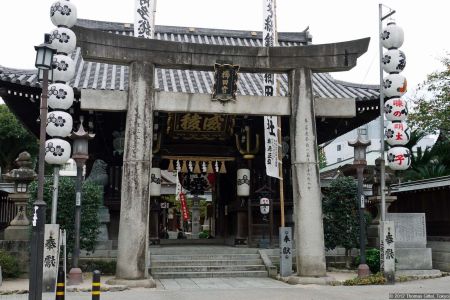



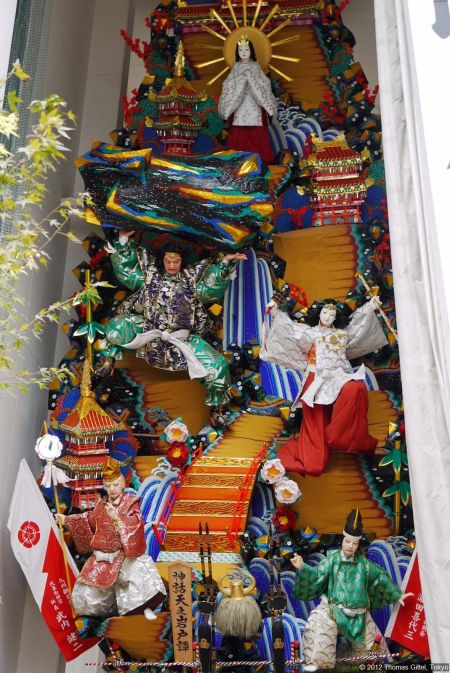















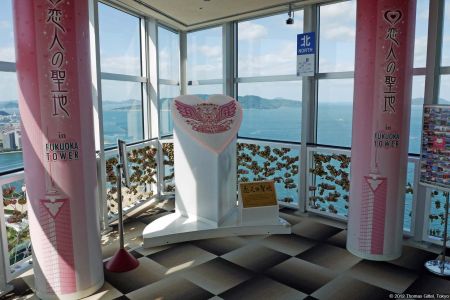
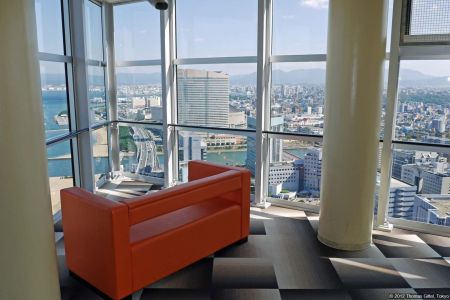








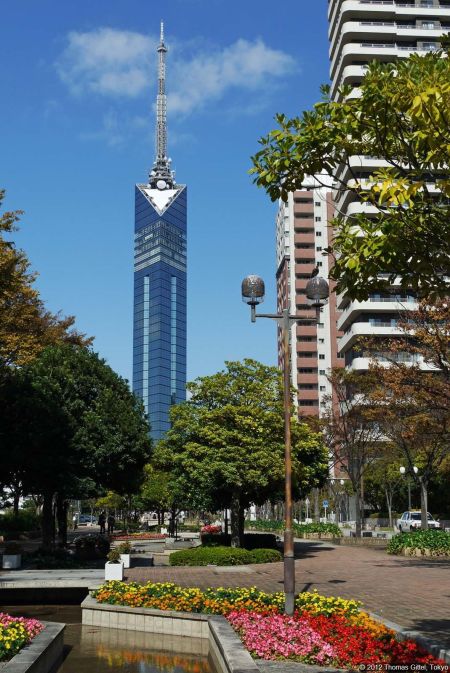














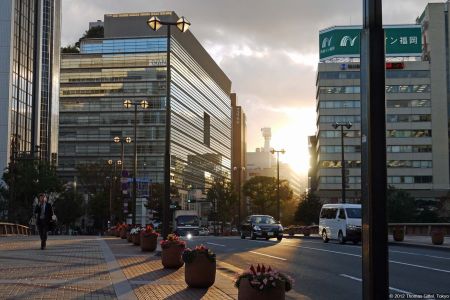







[…] be continued… Fukuoka, the Hill of Good Luck – 福岡 (Part 2) – Old and new – so close […]
[…] Fukuoka, the Hill of Good Luck – 福岡 (Part 2) […]
[…] is the area with the city beach, the Fukuoka tower and the robosquare. I love the sea, so for me living in a […]